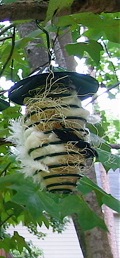- Bird Accessories, Bird Nesting Materials, Fruit Bird Feeder, Nesting Material, Suet Feeders, Uncategorized
be ready for the season with homemade nesting materials
The cold weather of winter leaves behind some clues for us (if we look) from the previous busy season of the avian world. Simply look up and take notice. Barren-looking trees with their foliage stripped will reveal the nests of several species, and what they’ve used for nesting materials.
Large, messy nests are usually the work of squirrels, while a smaller nest consisting of twigs and grasses may be that of a Cardinal, Blue Jay, or Mockingbird. An even smaller nest with tightly woven plant fibers, maybe even some milkweed or thistle down still attached would be the work of an American Goldfinch. You’d have to search a bit harder to find nests from Bluebirds, Chickadees, or Nuthatches, as these birds nest in cavities or birdhouses. You can easily encourage nest building around your place this season by offering nesting materials before the season actually starts. Although there are many cool kinds of materials and holders available, this is most definitely a “do-it-yourselfer”!
Start by gathering nesting materials now. Feathers and pet hair are preferred by Chickadees, while decorative mosses (Spanish, Sphagnum, and that thin, curly straw-like stuff) might be used by many species mentioned above. Bright cotton yarns add a nice touch too, as variety is the spice of life. Although I’ve always heard that dryer lint is a good one… our local birds have never touched it when previously offered. Stay away from plastics, fishing line, and the like. These can get tangled around nestlings or their legs, proving to be hazardous, and sometimes fatal.
Now, what to put your nesting materials in? That part is simple! A standard suet cage works perfectly, as do the mesh produce bags from the grocery store (the kind apples come in). The
Spring Feeder shown here is just that, meant for fruit or suet. We’ve found whole peanuts and our nesting materials work great in them too. Talk about versatility! Put a mixture of materials in several holders and hang them from branches around your yard where the birds will see them. Do pull some materials through to get started, but don’t pack them in too tightly. Birds need to be able to pull them out fairly easily, and should the rain saturate the nesting material, it will dry quickly if air can flow through it. So start gathering… and here’s to many successful broods this season!
-
The Pop-Outz is Great for Nesting Materials Too!
This mod, recycled plastic thing is called a Pop-Outz. It’s actually a suet feeder that makes for a new and fun way to feed birds this convenient an economical treat. Suet greatly benefits birds in winter as it’s loaded with extra fat and protein. These calories are converted into energy which helps birds stay warm in frigid weather.
We’ve given away hundreds of these feeders with orders, just because they’re so groovy and versatile… and they help keep plastics out of landfills too 🙂
Versatile? You bet! Pop-Outz make for the perfect vessel for offering nesting materials to birds. In our notes to customers, here’s what we tell them: “In early spring the Pop-Outz is perfect for offering nesting materials. Bright cotton yarns, feathers, decorative mosses, and even pet hair are a few favorites to encourage nest building around the yard. Just fill, pull some materials through the holes to get started, and hang from a branch where birds will see it. Enjoy!” Now if you’ve made a purchase with The Birdhouse Chick in the past year or two, you’ve likely seen that note before!
Nesting materials will usually work in any kind of suet feeder, but these are just fun, and something a little different than the standard cage. Put your suet feeder to work super duty year-round. In summer, fruit is a great choice for migratory birds, whole peanuts work well in cold weather, and of course, load up with home made nesting materials in early spring to encourage nest building around your yard!
-
nesting materials that could pose hazards?
There was a pretty strange video and some interesting discussions on one of the birding forums where I’m subscribed. For the above title to make any sense at all, you’d need to watch the very short video about conjoined robins and the follow-up to the story involving nesting materials. Check it out:
Luckily for the robins, they did make it to a caring vet who performed the surgery to separate them pro bono. Turns out genetics were not the culprit, but a small piece of plastic thread in their nesting materials. After they hatched, it had caused there skin and wings to fuse to it, thus developing together. The prognosis for the larger bird is good and he will be released back into the wild. For the smaller robin, his life may be lived out permanently at the rehab center if he survives. His wing needed to be clipped in order to separate the two birds.
Our discards are killing wildlife… especially birds. Fishing line and similar materials pose a life threatening hazard to all wildlife and in particular wild birds. Sadly but surely we kill the planet that sustains us all.



